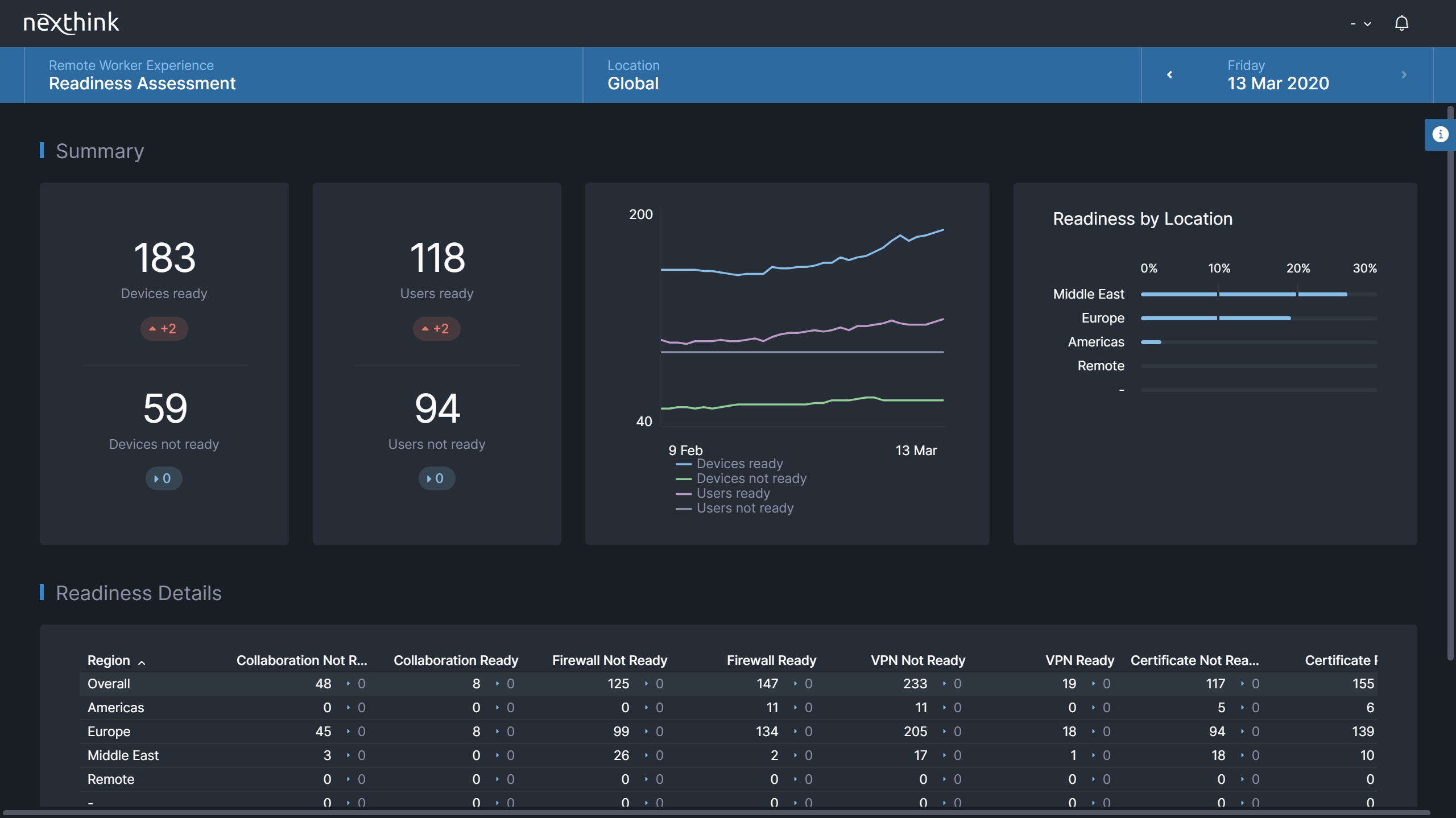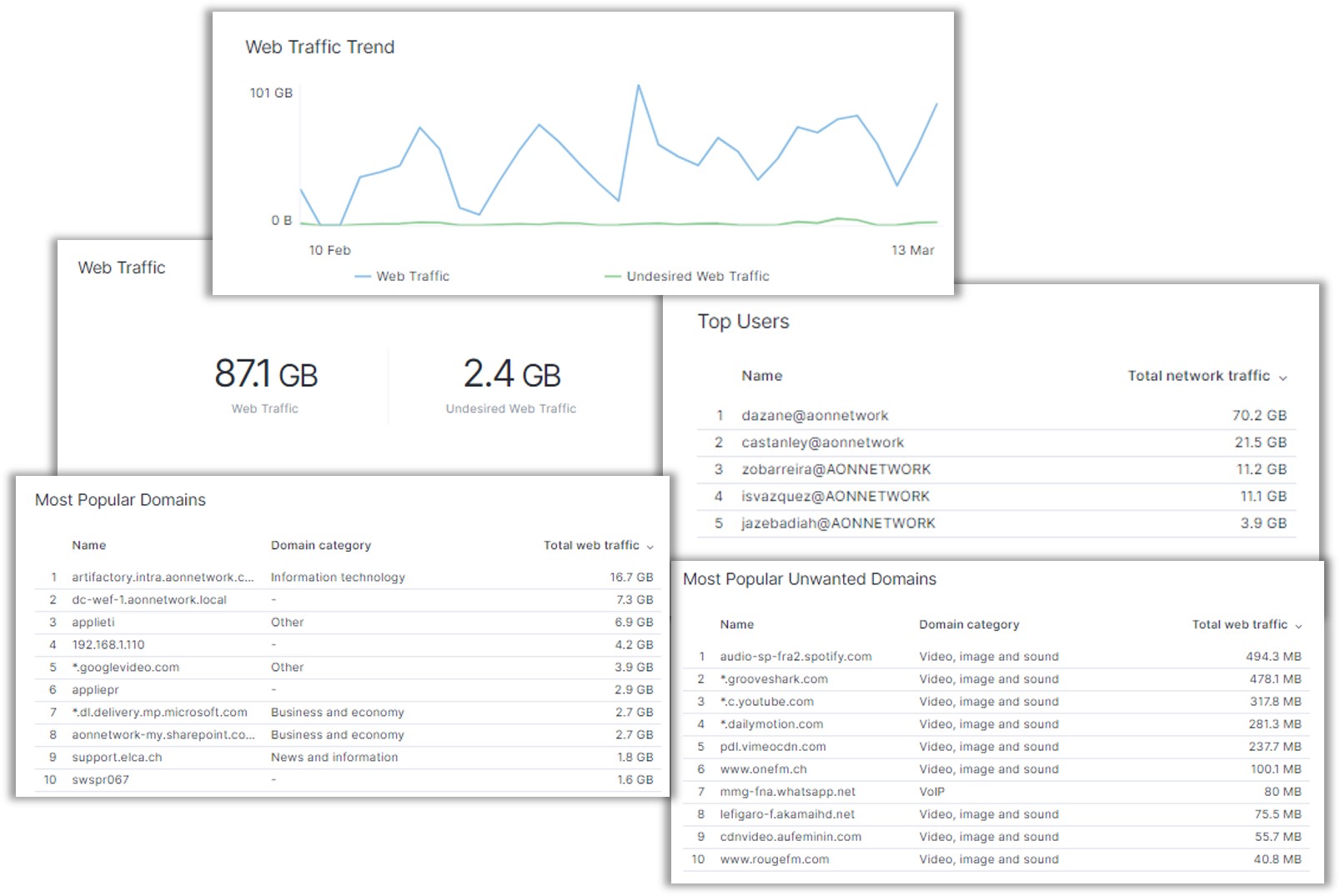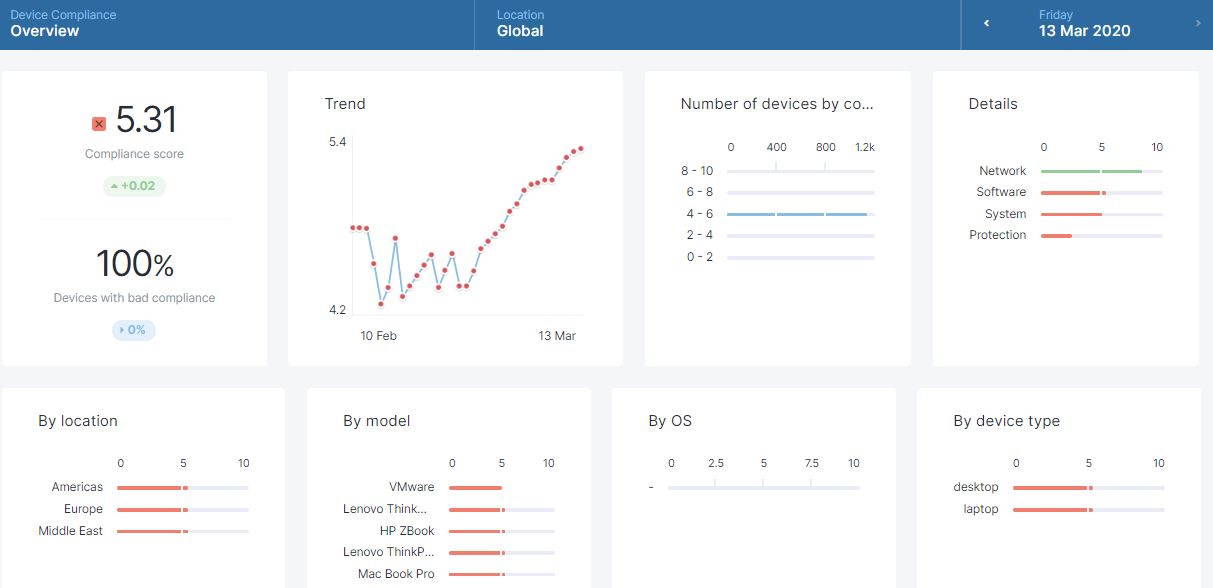Though there is an entire industry devoted to telling you otherwise, most people prefer to work for large organizations. On the one hand, their appeal makes perfect sense. Big employers offer higher salaries, better benefits, and a longer employee tenure.
Yet, there are some noticeable wrinkles that come with life in a large organization. Chief among them, bigger companies often exhibit a poor overall Digital Employee Experience. Research conducted by Vanson Bourne shows that over half of office workers believe IT issues are an accepted norm at their companies, and that on average, each worker experiences roughly 100 technology interruptions per year. At a company of 10,000 employees, these interruptions can cost businesses up to $25 million.
Add in the novelty of remote work and the inherent bureaucracy that can come with a big organization, and it’s apparent that IT has its work cut out for them.
Fortunately, our customers have flipped this script by using Nexthink to fix their most pressing technology problems and to cut through their organizational silos.
Get the best pods, articles, & research in IT experience
Choose CountryAfghanistanAlbaniaAlgeriaAndorraAngolaAntigua & DepsArgentinaArmeniaAustraliaAustriaAzerbaijanBahamasBahrainBangladeshBarbadosBelarusBelgiumBelizeBeninBhutanBoliviaBosniaHerzegovinaBotswanaBrazilBruneiBulgariaBurkinaBurundiCambodiaCameroonCanadaCape VerdeCentral African RepChadChileChinaColombiaComoros CongoCongo (Democratic Rep)Costa RicaCroatiaCubaCyprusCzech RepublicDenmarkDjiboutiDominicaDominican RepublicEast TimorEcuadorEgyptEl SalvadorEquatorialGuineaEritreaEstoniaEthiopiaFijiFinlandFranceGabonGambiaGeorgiaGermanyGhanaGreeceGrenadaGuatemalaGuineaGuinea-BissauGuyanaHaitiHondurasHungaryIcelandIndiaIndonesiaIranIraqIreland (Republic)IsraelItalyIvory CoastJamaicaJapanJordanKazakhstanKenyaKiribatiKorea NorthKorea SouthKosovo KuwaitKyrgyzstanLaosLatviaLebanonLesothoLiberiaLibyaLiechtensteinLithuaniaLuxembourgMacedoniaMadagascarMalawiMalaysiaMaldivesMaliMaltaMarshall IslandsMauritaniaMauritiusMexicoMicronesiaMoldovaMonacoMongoliaMontenegroMoroccoMozambiqueMyanmar (Burma)NamibiaNauruNepalNetherlandsNew ZealandNicaraguaNigerNigeriaNorwayOmanPakistanPalauPanamaPapuaNew GuineaParaguayPeruPhilippinesPolandPortugalQatarRomaniaRussian FederationRwandaSt Kitts & NevisSt Lucia Saint Vincent & the GrenadinesSamoaSan MarinoSao Tome & PrincipeSaudi ArabiaSenegalSerbiaSeychellesSierraLeoneSingaporeSlovakiaSloveniaSolomon IslandsSomaliaSouth AfricaSouth SudanSpainSri LankaSudanSurinameSwazilandSwedenSwitzerlandSyriaTaiwanTajikistanTanzaniaThailandTogoTongaTrinidad & TobagoTunisiaTurkeyTurkmenistanTuvaluUgandaUkraineUnited Arab EmiratesUnited KingdomUnited StatesUruguayUzbekistanVanuatuVatican CityVenezuelaVietnamYemenZambiaZimbabwe
By checking the box you understand that Nexthink will process your
personal information in accordance with our Privacy Policy.
Subscribe
Big but lean – solving IT issues across 8,500 devices
With the right tech, IT can make even the biggest and most bureaucratic of organizations become agile and resilient. One of our customers, a large public administration agency in France, is the perfect example.
When COVID hit this year, their IT department had to safely and quickly transition 8,000 employees to a remote work environment (the remaining 500 stayed onsite). The agency was organized more like a loose federation of kingdoms than a single enterprise—employees spanned 47 different departments, each with their own IT manager to look after their digital demands. Some staff were mobile and equipped with laptops, but most were onsite, desktop-bound employees. Each department’s IT manager reported into the agency’s central IT department, but like many big organizations, this team had little insight into how their employees were experiencing and consuming the company’s private networks, business applications, and work devices.
Moving to remote work, prompted IT to use Nexthink to help address a number of critical objectives:
Ensure endpoint VPN readiness
- The agency’s employees had to leave the office on such short notice that IT didn’t have the capacity to run a proper readiness assessment using their existing ITSM tools. With Nexthink’s dashboards, their IT department was able to immediately diagnose whether their employees’ devices (laptop and desktop), and their VPNs and Firewalls were ready to move offsite.

Use our readiness assessment dashboards to guide your next digital transformation project.
Adjust VPN licenses to match employee demand
- Previously, IT’s network team could only track the number of open sessions on their VPNs, but that was about it. They had no idea what users connected to each of their networks and how much data they consumed. Nexthink revealed this information in real-time, allowing IT to monitor the exact number of VPN licenses that were active and how much data each user withdrew from the network.

Identify the root causes to your network, application, and end user problems.
Certify endpoint compliance
- Each department’s IT manager needed a way to ensure their employees’ devices were successfully encrypted. Using Nexthink’s remote automations, they were able to instantly unlock health information on their devices’ TPM chips. They could see whether these chips were installed and active, what versions they had, and confirm their BIOS was working correctly—all information that allowed these IT managers to diagnose hundreds of endpoints in just a few days.

Nexthink’s experience scoring system makes it easy for support to cross-check device, system, software, & network compliance
Deploy Microsoft Exchange 2016 without end user issues:
- IT was also in the process of migrating from MS Exchange 2010 to 2016. There were several complaints from employees that Outlook was slow, but the L1 and L2 help desk couldn’t determine if this was an application or network issue. Using Nexthink’s digital experience score system, IT was able to quickly detect a pattern: every time the agency’s Outlook score dropped, the VPN would crash. Within the same Nexthink UI, both L1 and L2 technicians were able to drill-down into their users’ application and network experience data and fix any errors with our built-in remediation scripts.

Our integrations with popular ITSM tools like Service Now, empower L1 and L2 technicians to solve problems faster
Understand employee computing context
- IT was understandably nervous about how their employees would respond to working remotely, especially for those that had never done this before. But using Nexthink’s endpoint targeting and on-screen messaging features, they were able to collect helpful feedback from users regarding their VPN experience and open a line of communication that was more direct and user friendly.

Our on-screen messaging and targeting features help IT corroborate hard data with unique employee insights.
Endpoint protection at home or in the office
Whether planning for an eventual return to the office, or a transition to a “work from anywhere” hybrid model—the agency’s IT team will use Nexthink to conduct a full scan of their employees’ devices to ensure they have the latest antivirus protection and are safe enough to connect back to their internal network.
Our critical services dashboards are helping IT to monitor their employees’ remote devices and ensure they continue to have the latest VPN certificates and collaboration tools, and that their firewalls, malware and user accounts are correctly installed and stable.
With all 47 IT managers using Nexthink, the agency has achieved a level of transparency they never thought was possible. Not bad for a big, “bureaucratic”, public agency.
Nexthink is helping several enterprise tech teams solve their most demanding remote work problems. We’re here to advance the Digital Employee Experience, whether people work from home or the office.
Get the best pods, articles, & research in IT experience
Choose CountryAfghanistanAlbaniaAlgeriaAndorraAngolaAntigua & DepsArgentinaArmeniaAustraliaAustriaAzerbaijanBahamasBahrainBangladeshBarbadosBelarusBelgiumBelizeBeninBhutanBoliviaBosniaHerzegovinaBotswanaBrazilBruneiBulgariaBurkinaBurundiCambodiaCameroonCanadaCape VerdeCentral African RepChadChileChinaColombiaComoros CongoCongo (Democratic Rep)Costa RicaCroatiaCubaCyprusCzech RepublicDenmarkDjiboutiDominicaDominican RepublicEast TimorEcuadorEgyptEl SalvadorEquatorialGuineaEritreaEstoniaEthiopiaFijiFinlandFranceGabonGambiaGeorgiaGermanyGhanaGreeceGrenadaGuatemalaGuineaGuinea-BissauGuyanaHaitiHondurasHungaryIcelandIndiaIndonesiaIranIraqIreland (Republic)IsraelItalyIvory CoastJamaicaJapanJordanKazakhstanKenyaKiribatiKorea NorthKorea SouthKosovo KuwaitKyrgyzstanLaosLatviaLebanonLesothoLiberiaLibyaLiechtensteinLithuaniaLuxembourgMacedoniaMadagascarMalawiMalaysiaMaldivesMaliMaltaMarshall IslandsMauritaniaMauritiusMexicoMicronesiaMoldovaMonacoMongoliaMontenegroMoroccoMozambiqueMyanmar (Burma)NamibiaNauruNepalNetherlandsNew ZealandNicaraguaNigerNigeriaNorwayOmanPakistanPalauPanamaPapuaNew GuineaParaguayPeruPhilippinesPolandPortugalQatarRomaniaRussian FederationRwandaSt Kitts & NevisSt Lucia Saint Vincent & the GrenadinesSamoaSan MarinoSao Tome & PrincipeSaudi ArabiaSenegalSerbiaSeychellesSierraLeoneSingaporeSlovakiaSloveniaSolomon IslandsSomaliaSouth AfricaSouth SudanSpainSri LankaSudanSurinameSwazilandSwedenSwitzerlandSyriaTaiwanTajikistanTanzaniaThailandTogoTongaTrinidad & TobagoTunisiaTurkeyTurkmenistanTuvaluUgandaUkraineUnited Arab EmiratesUnited KingdomUnited StatesUruguayUzbekistanVanuatuVatican CityVenezuelaVietnamYemenZambiaZimbabwe
By checking the box you understand that Nexthink will process your
personal information in accordance with our Privacy Policy.
Subscribe
Related posts:
- Your MS Teams Rollout Needs Specific Help—Not General Guidance
- What Your IT Chatbot Can Look Like Running on Full Power
- 8 Websites Every End-User Computing Professional Needs to be Visiting Daily
- The Ultimate List of Digital Employee Experience Job Titles